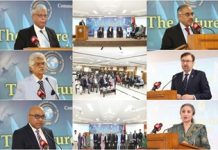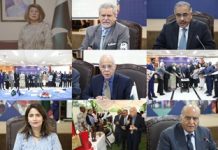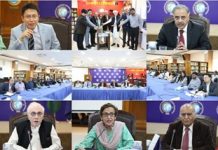The scenes witnessed on May 12 had a dangerous dimension not possessed by normal political clashes: the ethnic character of the group used by the government for its political purposes, without the slightest thought to its action’s wider and long-term ramifications for the country
May 12 will be known as the blackest day in Pakistan’s political history, not just for blatant use of violence by a local ally of the ruling coalition in Karachi but also for the deliberate inaction of the top political players of the provincial and federal governments. Never before have we seen young men dying helplessly, injured victims of bullets being pulled out of an ambulance and shot dead, and a television network under attack for more than six hours without any law enforcement agency coming to its assistance. These gruesome pictures and scenes will remain in our national memory for a very long time.
Political violence is not a unique feature of Karachi or Pakistan; many other countries have experienced it, and if we wish to learn anything from it our own history can give us bitter lessons on the subject. Political violence, particularly the kind planned by ruling groups, only breeds more violence and has vertical and horizontal dimensions. Once in a vicious cycle of violence, communities can rarely come out of it, even with the best of efforts. Lebanon, Iraq, Afghanistan and our own ethnic violence in the past should serve as stark reminders.
The scenes witnessed on May 12 had a dangerous dimension not possessed by normal political clashes: the ethnic character of the group used by the government for its political purposes, without the slightest thought to its action’s wider and long-term ramifications for the solidarity of the country.
The second lesson that should not be lost on us is that the use of violence by governments has historically failed in cowing down agitated masses. Each episode of brutality provoked more anger and distanced the rulers from the society. Their reliance on private armed groups to commit murders and instil fear among the opposition political workers was a sign of desperation, weakness and a sort of parting kick. What happened in Karachi makes me wonder if the ruling coalition and its top leader have lost hope of retaining power through legitimate, constitutional means, and are prepared to do anything to stay in power.
Besides violence when and where practical, in the past political leaders on the decline have used artificial political gatherings and rallies to demonstrate their popularity. General Pervez Musharraf’s political course since his fateful decision to bring the superior judiciary under his thumb in March is no different from our past political losers. A large liberal section of Pakistan pinned high hopes on him when he took over, ignoring constitutional issues of military intervention. They were perhaps impressed by his candid way of explaining political issues and his confidence that he could help correct our political path and help make the transition to constitutional rule.
It is too hard for any one to stay hopeful and positive for seven and half years. I believe Musharraf did not face any political challenge until March 9, despite many concerns about governance, corruption and the strange bedfellows he had in the Punjab and urban Sindh. Even the damage that he caused himself by sending the judicial reference against the Chief Justice of Pakistan could be controlled had he listened to any good advice or allowed himself rational calculation. It is not a cliché but a truism that politics is the art of compromise, and it requires subordination of personal egos to a larger political interest.
The quick eddy of political events has taken any option of compromise with the judiciary, supported by the solid rock of the legal community, out of the General’s hands. What could be a legal or judicial issue has become a major constitutional and political one. I would argue that the very first step to seek removal of the Chief Justice was inspired by a political motive. Even if that was not the intention of the president, the legal community, civil society and political opposition, alienated by past assaults on the judiciary’s independence, quickly interpreted the move as driven by political considerations.
Historically, politics have never been conducted in a spirit of fair play; rather they are judged by how the actors use legal and other means to succeed. Therefore I find the comment that the opposition is politicising a judicial issue amusing, as neither these words nor those who utter them sound credible to the public. Yes, public rallies and defiance by the bar councils and their continuing solidarity with the cause of the judiciary have a political tint, but there is nothing wrong with this. The only difference between good and moral, and immoral and bad politics is the question of constitutionality.
Musharraf’s latest declaration that “politics will be countered by politics” and the fact that he chose to address rallies in his support on the day the chief justice was to address the Sindh High Court Bar Council in Karachi, shows signs of political desperation. He and his allies were politically shaken by the massive turn out of people on May 5, when the Chief Justice travelled from Islamabad to Lahore. The poor show at the ‘mammoth’ proves that the Punjab’s political mood has shifted against them. With the best of efforts, freely flowing funds and massive use of governmental machinery, they could not hire or persuade more than twenty thousand to an ill-disciplined rally.
Allowing the lawyers and the opposition parties on the sidelines to march in the streets of Karachi would have broken the myth that Musharraf’s allies have an effective and strong social support base in Karachi. The counter rally of the MQM, attended by only a few thousands under the shadow of gun-totting workers, badly exposed its declining popularity in the city any way.
It is clear that the country is divided between those who want Musharraf to go and those who seek his survival. There are too many big stakes in the evolving political crisis at both ends of the political divide, which explains some parties’ and groups’ desperation. The events of May 5 and 12 have proved to be turning points; they have practically disabled the government from rethinking its decisions or reaching out to the opposition for a political settlement that would put the country on the path of democracy.
President Musharraf and his associates continue to live in the illusion that they can control the situation and continue to live with a manufactured legitimacy. Or they might believe they can intimidate the opposition, or even unleash terror using private groups on the pattern of Karachi, or use repressive measures to bring back stability in the country. My reading of the evolving political crisis is not that charitable. We are moving towards a long spell of agitation that may paralyse the country, with disastrous effects on economy, law and order and ethnic harmony. It is already happening.
There were brutally contrasting scenes and sentiments in the country on Saturday. Men brought to Islamabad by district nazims and ministers danced in front of the national parliament to the beat of dhol, in the traditional Punjabi bhangra style, as young men in Karachi fell to violence. The Railway Minister Sheikh Rashid Ahmed called it the “awakening of Punjab”, and congratulated the people. This reminds me of the very perceptive title of M Asghar Khan book, “We have learnt nothing from history”.
The author is a professor of Political Science at the Lahore University of Management Sciences.












